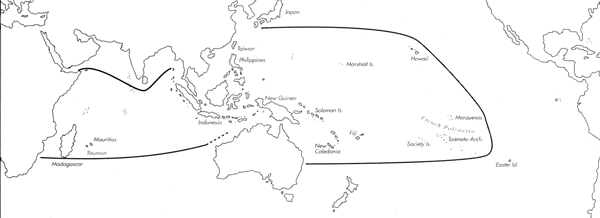
Skip Navigation Links
View access keys for this site.

Range: E. Africa and Maldives to French Polynesia and Hawaii.
Description: Moderately small to moderately lare, moderately solid to solid. Last whorl conical; outline slightly to moderately convex adapically and straight below, occasionally faintly concave at centre. Shoulder angulate, tuberculate to strongly tuberculate. Spire low, outline nearly straight; with convex apex. Postnuclear spire whorls with closely spaced tubercles. Teleoconch sutural ramps flat to faintly concave, with 2-3 distinct or inconspicuous spiral grooves. Last whorl with weak, smooth or granulose spiral ribs near base.
| Shell Morphometry | ||
|---|---|---|
| L | 30-61 mm | |
| RW | 0.15-0.40 g/mm | |
| (L 35-48 mm) | ||
| RD | 0.52-0.60 | |
| PMD | 0.85-0.98 | |
| RSH | 0.03-0.13 | |
Last whorl almost completely yellowish to dark brown or olive, sometimes with a lighter central spiral band. Background tinged with greyish blue or violet. Base and basal part of columella dark violet. Tip of apex usually purplish blue; Reeve reports a rose-tinted apex. Postnuclear sutural ramps either immaculate bluish grey to white or radially maculated with colour of last whorl; tubercles mostly immaculate. Aperture dark violet behind an orange-brown margin.
Periostracum yellowish brown, thin, translucent, minutely tufted on the shoulder tubercles (Kohn, 1959a; Cernohorsky, 1964).
Dorsum of foot brownish red, mottled with brown and tipped with red. Rest of foot and rostrum yellowish brown, mottled with darker brown. Sole of foot may be orange-brown, edged with orange. Tentacles white or pale yellow. Tip of siphon dark orange or yellow, followed proximally by black and pink, yellow or red bands; rest of siphon yellow mottled with black (Hawaii: Kohn & Weaver, 1962; Seychelles: Kohn, unpubl. observ.).
Habitat and Habits: In 1-50 m, mainly encountered in 8-20 m on reef substrata. Egg capsules of about 10.5 x 8 mm are attached to the underside of coral rocks. Basal plates remain separated. Capsules contain 2,300-2,400 eggs about 150 ┬Ám diameter, suggesting a minimum pelagic period of about 28 days (Kohn, 1961b; Perron & Kohn, 1985).
Discussion: C. moreleti can only be mistaken for C. lividus or C. sanguinolentus. These species both differ considerably in their broader last whorl (RD: C. lividus 0.59-0.73; C. sanguinolentus 0.60-0.71) and often have a relatively higher spire (RSH: C. lividus up to 0.20; C. sanguinolentus up to 0.16). The tubercles of the spire whorls are more widely spaced in the two latter species. The colour pattern of the body described above occurs neither in C. lividus nor in C. sanguinolentus. C. lividus has a weaker tuberculation of the postnuclear whorls, and C. sanguinolentus often differs in having a slightly pyriform last whorl.

C. moreleti Range Map
This section contains verbatim reproductions of the accounts of 316 species of Conus from the Indo-Pacific region, from Manual of the Living Conidae, by R÷ckel, Korn and Kohn (1995). They are reproduced with the kind permission of the present publisher, Conchbooks.
All plates and figures referred to in the text are also in R÷ckel, Korn & Kohn, 1995. Manual of the Living Conidae Vol. 1: Indo-Pacific Region.
The range maps have been modified so that each species account has it own map, rather than one map that showed the ranges of several species in the original work. This was necessary because each species account is on a separate page on the website and not confined to the order of accounts in the book.
Return to framed version (returns to search page)